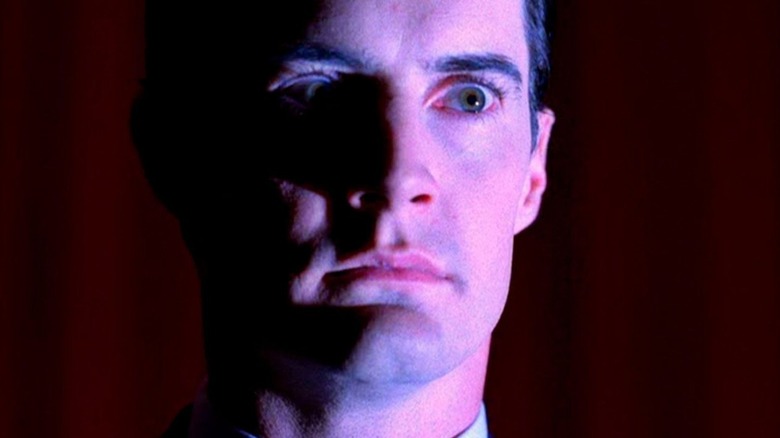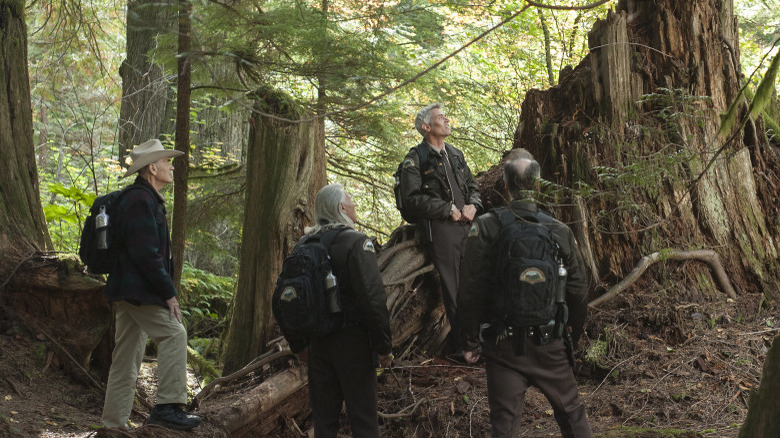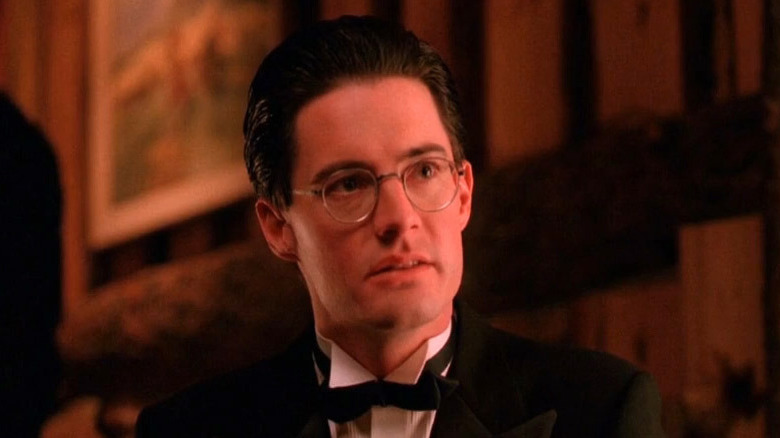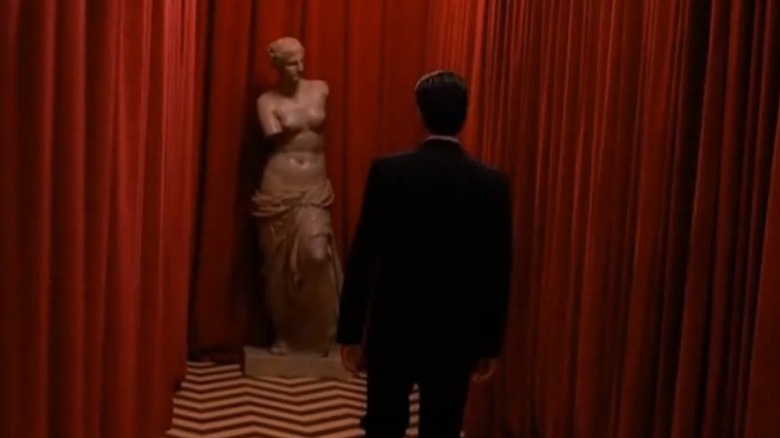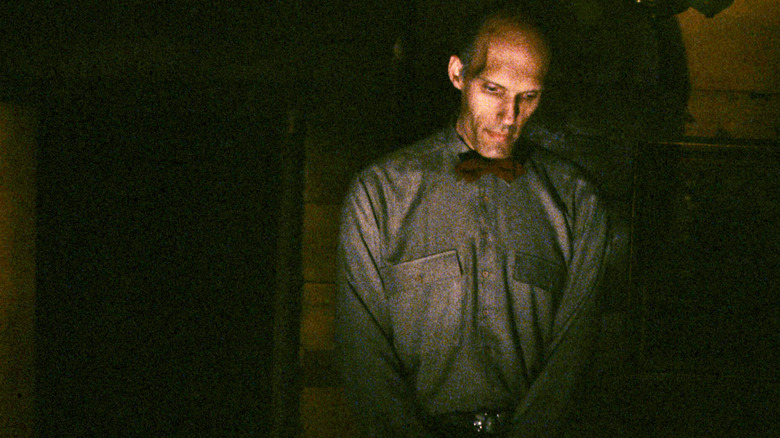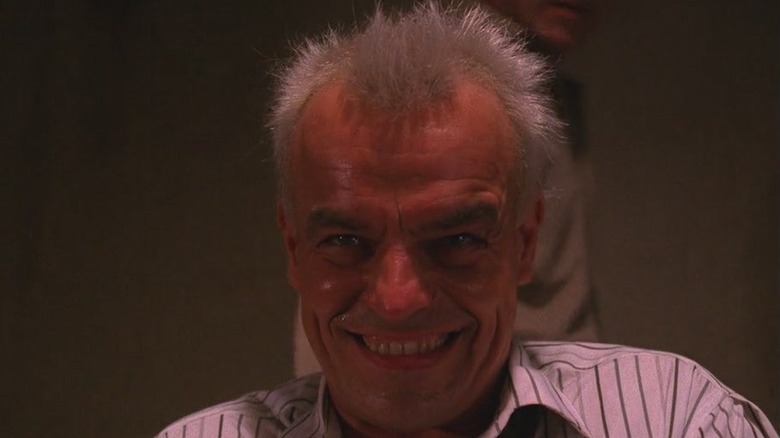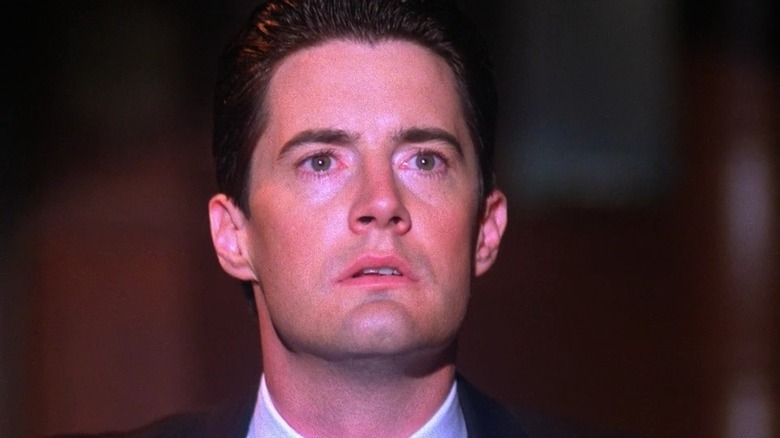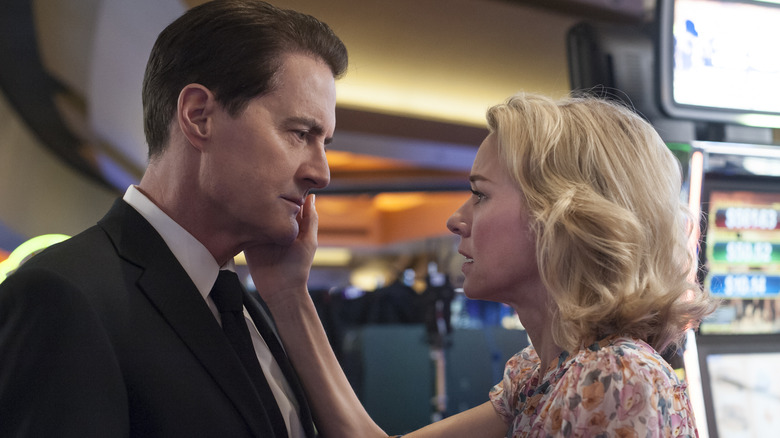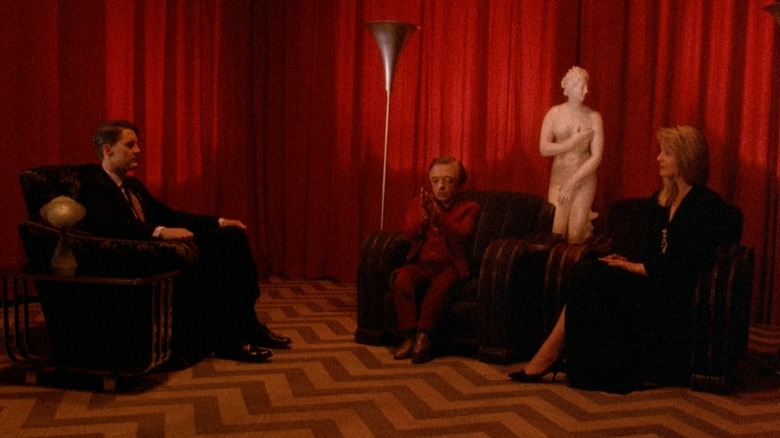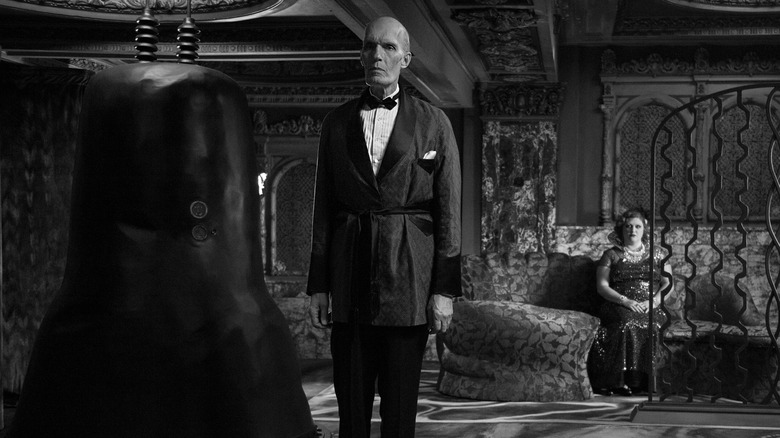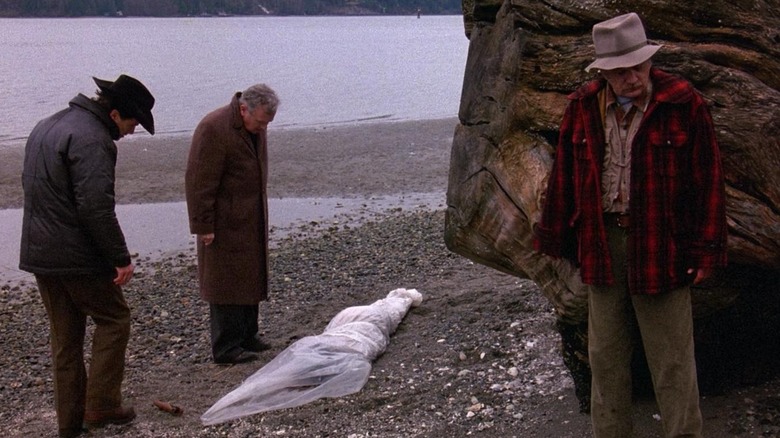The 10 Best Twin Peaks Episodes, Including Season 3
The wonderful and strange world of "Twin Peaks" has captivated television and cinema audiences for decades, leaving a lasting impact on serialized storytelling in television long after its original run. Co-created by film director David Lynch and novelist Mark Frost, "Twin Peaks" was led by Kyle MacLachlan as Special Agent Dale Cooper, who investigated the murder of a teenage girl named Laura Palmer (Sheryl Lee). As Cooper soon discovered, Laura lived a double life, and the investigation was rife with secrets and dramatic developments. The town of Twin Peaks itself was full of quirky and memorable characters, and the show blended soap drama, comedy, and the surreal, as supernatural forces were in full effect in this twisty, oddball world.
After running for two seasons and 30 episodes on ABC from 1990 to 1991, "Twin Peaks" was canceled, but Lynch followed it up with a feature film called "Twin Peaks: Fire Walk With Me" that depicted Laura Palmer's final days. Over two decades later, Showtime revived the series. The massive script from Lynch and Frost was cut into 18 parts, all of which Lynch directed himself. Out of the 48 televised "Twin Peaks" episodes, we've selected 10 of the most essential, listing them from best to worst (while "Fire Walk With Me" doesn't count — it's a movie, not an episode — it is still required viewing for any "Twin Peaks" fan).
10. We Are Like the Dreamer — Season 3, Episode 14
For many devotees of "Twin Peaks," the Showtime revival was odd and unexpected, even by "Twin Peaks" standards. Many of the show's plot lines took the viewers away from the eponymous town and to other locations around the country, telling a wider story and depicting a conspiracy that goes deeper into the fictional universe's lore. But Part 14 takes some of the action back to Twin Peaks itself, with the Sheriff's Department in particular playing a bigger role. Sheriff Truman, Hawk, Bobby, and Andy head into the woods under the direction of the late Major Briggs, and Andy goes through his own surreal experience, meeting the Fireman and absorbing a wealth of information relevant to the rest of the series.
Meanwhile, the elderly Sarah Palmer has a horror movie moment in which she assumes a demonic appearance and brutally murders a trucker. James has a new job as a security guard at the Great Northern Hotel and speaks to Freddie, a new character who wears a garden glove that gives him super strength. Outside of the town, the origin of the term "blue rose case" gets an explanation from Albert Rosenfield and Gordon Cole. Part 14 makes great use of the original "Twin Peaks" cast members, putting them in new and weird situations that they wouldn't get into in the original series. At the same time, Lynch and Frost flesh out the world, while setting things in motion for the ending.
9. The Last Evening — Season 1, Episode 8
By the time that the first season of "Twin Peaks" ended, it had become a hit nationwide. The mystery of Laura Palmer gripped audiences, and while "The Last Evening" didn't give viewers concrete answers, this season finale left a lot to chew on. Dale Cooper is hot on the trail of Leo Johnson and Jacques Renault, two ne'er-do-wells suspected of involvement with Laura Palmer's murder. Cooper and local gas station owner Ed Hurley go undercover in a brothel and casino called One Eyed Jacks, where they discover that Leo and Jacques were with Laura on the night she died. After Jacques is shot, arrested, and hospitalized, he is smothered to death by a distressed Leland Palmer, who had been acting erratically throughout the season.
Violence and drama also strike the town's sawmill, which Leo sets on fire. A number of characters get involved in the kerfuffle, resulting in Leo being shot. And if that wasn't enough, the episode ends with Dale Cooper opening a door and getting shot by an unknown assailant. The season 1 finale of "Twin Peaks" was full of high emotion and shocking developments, all culminating in a massive cliffhanger that proved that "Twin Peaks" was must-see TV.
8. Beyond Life and Death — Season 2, Episode 22
The 2nd Season of "Twin Peaks" was significantly longer than the 1st, lasting 22 episodes, compared to the 1st season's eight. With the mystery behind Laura Palmer's murder solved in the middle of Season 2, the rest of the season is generally considered a low point for "Twin Peaks" as a whole. After some padding and a plot line that gave Dale Cooper a nemesis in the form of former FBI Agent Windom Earle, the final episode of the original run of "Twin Peaks" was a return to form. David Lynch returned to the director's chair for the first time since Episode 7 of Season 2, and "Twin Peaks" reminded fans why they loved the show in the first place — namely, the eccentric characters and surreal sequences.
After Dale Cooper's love interest Annie is kidnapped by Earle, Cooper pursues him all the way to the Black Lodge, resulting in a trippy sequence reminiscent of those from the first season. Cooper encounters familiar characters from this realm, such as the Giant, the Man From Another Place, and Laura Palmer herself, before discovering the concept of doppelgängers and ending up stranded in the Black Lodge. As a final plot twist — one that wouldn't be resolved for decades — Cooper's doppelgänger replaces him in the real world, laughing menacingly at the camera as blood drips down his head.
7. May the Giant Be With You — Season 2, Episode 1
There aren't too many cliffhangers more shocking than the protagonist getting shot, and the 2nd season premiere of "Twin Peaks" had the unenviable task of resolving the 1st season finale's big twist. As the informal title of the episode, "May the Giant Be With You," implies, this opener introduces fans to the Giant, a figure from the Black Lodge who became a series staple — and a fan-favorite — for the rest of its run. The Giant visits Dale Cooper as he lies on the floor, bleeding. As he will do for the rest of the series, the Giant provides Cooper with essential clues, including the memorable phrase, "The owls are not as they seem."
As Cooper recovers, young Audrey Horne, still infatuated with Cooper, tries to help with the investigation by going undercover at One Eyed Jacks. At the same time, the Palmers continue to spiral downwards, with Leland Palmer suddenly growing white hair. This season opener is full of character development for many of Twin Peaks' inhabitants, utilizing its ensemble well while keeping the plot moving and expanding on the mystery in dramatic fashion.
6. Arbitrary Law — Season 2, Episode 9
Earlier in Season 2, the audience found out that Leland Palmer (Ray Wise), possessed by the evil entity known as BOB, was Laura Palmer's true killer. Following Leland's murder of Laura's cousin, Maddy Ferguson, Dale Cooper and the Sheriff's Department get closer to the truth. In a feat of deductive reasoning, Cooper gathers all suspects at the Roadhouse to determine who is BOB's host. Remembering an older clue, "That gum you like is going to come back in style," Cooper figures out that Leland was possessed by BOB and traps him in the interrogation room. BOB, through Leland, confesses to the murders and makes Leland kill himself, ending his dramatic and tragic plot line.
While the episode itself is a bit rushed and contrived, it provides closure for viewers speculating on the identity of Laura Palmer's murder, and it was a memorable final showcase for Ray Wise as Leland Palmer. It's an unbelievable and fantastical end to what started as a straightforward murder investigation, especially as the grounded FBI Agent Albert Rosenfield concludes that the demonic BOB is simply "the evil that men do."
5. Lonely Souls — Season 2, Episode 7
Any real detective would be delighted to have a murder mystery lead to a quick and obvious answer, but that certainly wouldn't make for good fiction. After 13 episodes and endless speculation on who killed Laura Palmer, Episode 14 ended with a twist — and a shocking and violent sequence. David Lynch both directed the episode and co-starred as loudmouth FBI Chief Gordon Cole. Dale Cooper and the others investigating the murder learn from an entity known as MIKE that Laura Palmer was killed by an evil force called BOB, and the search for BOB's human host begins. Cooper and the rest eventually conclude that Ben Horne is the murderer, working off of clues from Laura's diary and MIKE's behavior.
Unexpectedly, Leland Palmer turns on his niece Maddy Ferguson, revealing himself to be BOB's vessel. The episode ends with Leland killing Maddy in a similar fashion to Laura, and Cooper receives a vision from the Giant, who ominously states, "It is happening again." It's an uncomfortable and visceral death scene that stuck with viewers; at the same time, the episode provides levity through Nadine Hurley, who wakes up from a coma and believes that she is a young high school student. "Lonely Souls" captures the entire spectrum of "Twin Peaks," and rolls it all into a single package.
4. No Knock, No Doorbell — Season 3, Episode 16
The Showtime revival of "Twin Peaks" was called "The Return," obviously referring to the return of a classic — but the 18-part miniseries, essentially season 3 of "Twin Peaks," also followed the long-winded return of Special Agent Dale Cooper. After returning to our realm from the Black Lodge, Dale Cooper isn't really himself, having replaced the wrong doppelgänger and taking on the role of Dougie Jones. For most of "The Return," Cooper had been speaking in broken sentences, meandering aimlessly while somehow changing the lives of everyone who met Dougie Jones for the better. Then, an unfortunate case of electrocution puts Cooper in a coma, and he awakens fully realized as the Dale Cooper audiences know — intelligent, charismatic, and driven.
With new determination and with all of the knowledge he has gathered, Cooper uses all of the resources he has to track down his evil doppelgänger. As the classic "Twin Peaks" theme plays in the background, Cooper triumphantly states "I am the FBI." "Finally," MIKE replies, echoing the sentiments of everyone who was watching. The end of the episode also features a confusing conclusion Audrey Horne's story, who reprises Audrey's Dance in the Roadhouse before inexplicably waking up in a hospital, leaving this intriguing thread hanging.
3. Zen, or The Skill to Catch a Killer — Season 1, Episode 3
While there is a lot to say about Twin Peaks' unusual inhabitants, Special Agent Dale Cooper is the heart and soul of the series. Eccentric but extremely empathetic, the earliest episodes of "Twin Peaks" gave viewers everything they needed to know about how Cooper's brain works. The third episode of the series includes a memorable sequence in which Cooper demonstrates his thought process to the Twin Peaks Sheriff's Department — in it, he throws a stone at a bottle after a suspect's name is read, and notes whenever the rock hits the bottle. It's an unorthodox method, but it helps viewers acclimate to the strangeness of this world while also being pretty entertaining.
The episode is bookended by the first of many bizarre sequences in the Black Lodge, an otherworldly dimension that hosts the Red Room, a place with iconic red curtains and a black-and-white zigzag patterned floor. In this sequence, Cooper meets various entities, including the one-armed MIKE, the killer BOB, and the short, dancing Man From Another Place; the unsettling sequence also includes Laura Palmer herself, and all the characters speak in reverse. It is a creepy, unsettling, and bizarre scene that would end up defining the show — and would be parodied endlessly in popular culture.
2. Gotta Light? — Season 3, Episode 8
Watching "Twin Peaks: The Return" on Showtime on a weekly basis was occasionally frustrating, as the story moved at a slow pace and took unexpected tangents. But some of those side trips ended up being quite rewarding. Dale Cooper is not present in episode 8, but his evil doppelgänger plays an important role. After getting shot by an associate, the fake Cooper is revived by a number of ghastly "woodsmen," who tear him apart and reveal a BOB orb underneath.
The episode then goes from a chilling performance by Nine Inch Nails to a flashback of the very first atomic bomb blast in 1945, which proves to be a thrilling and terrifying visual effects spectacle. We get a possible origin story for BOB and the evil entity called Judy, as well as a look at why Laura Palmer is so essential to the plot. A mysterious scene involving the Giant (or the Fireman, as he is known in "The Return") highlights the nuclear blast, the woodsmen, and Laura. The rest of the episode focuses on 1956 New Mexico, where an insect-like creature and the woodsmen terrorize a small town.
It's a nightmarish but compelling episode, sort of like a dark, twisted version of "2001: A Space Odyssey." Despite having little dialogue, the episode's visual storytelling illuminated several important details about the nature of the "Twin Peaks" universe.
1. Northwest Passage — Season 1, Episode 1
It's hard to beat the original episode, as the "Twin Peaks" pilot makes an excellent argument for the show as a whole. This feature-length installment begins with Pete Martell finding the body of Laura Palmer on the riverbank, uttering the phrase "She's dead, wrapped in plastic" on the phone to police. From there, we get our introduction to Special Agent Dale Cooper, an unusual FBI agent who frequently leaves voice memos to a mysterious character named Diane. As the news of Laura's murder slowly makes its way through the town of Twin Peaks, viewers are introduced to the show's large ensemble cast, with complicated relationship dynamics and personal stresses lurking underneath all of them.
With strong directing from David Lynch, memorable character moments, and saliva-inducing scenes featuring cherry pie, coffee, and donuts helping characterize the show and its many personalities, the pilot ends with a mysterious vision from Sarah Palmer that helps set the tone for the rest of the run. Even after all this time, the first episode of "Twin Peaks" remains the most essential and best episode of the entire series.
